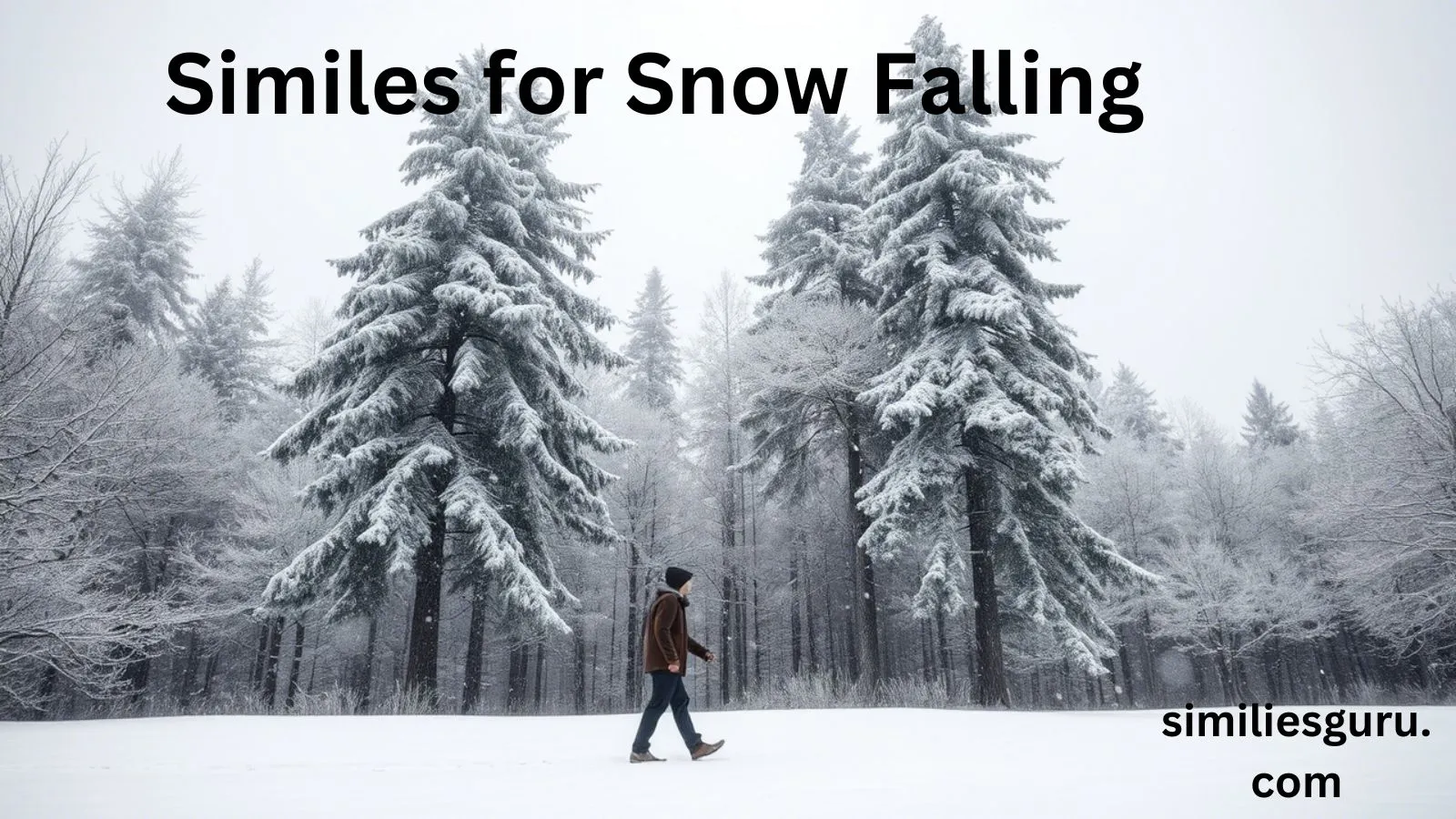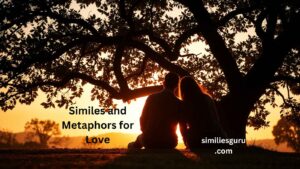Snowfall has long been a source of inspiration for poets, writers, and anyone who appreciates the beauty of nature. Its serene, quiet, and transformative qualities make it a perfect subject for creative expression. Similes, which compare one thing to another using “like” or “as,” are a powerful tool to vividly describe the magic of snow falling. In this article, we’ll explore 20 similes for snow falling, provide examples of similes in poems for kids, and offer casual alternatives to the phrase “similes for snow falling.” Additionally, we’ll include six texting examples that are user-friendly and optimized for Google.
Why Similes Matter in Describing Snow
Similes are more than just literary devices—they help us connect with the world around us by drawing parallels between the familiar and the unfamiliar. When it comes to snow, similes can evoke emotions, paint vivid pictures, and make descriptions more relatable. Whether you’re writing a poem, a story, or simply texting a friend, similes can elevate your language and make your message more engaging.
20 Similes for Snow Falling
Here are 20 creative similes to describe snow falling:
- Like a blanket gently covering the earth – This simile emphasizes the comforting and peaceful nature of snowfall.
- As soft as a whisper – Perfect for describing the quiet, almost silent descent of snowflakes.
- Like feathers drifting from the sky – This evokes the lightness and delicacy of snowflakes.
- As graceful as a ballerina’s pirouette – A poetic way to describe the elegant movement of falling snow.
- Like powdered sugar sifting onto a cake – A sweet and whimsical comparison.
- As silent as a secret – Highlights the noiselessness of snowfall.
- Like stars twinkling as they fall – A magical and celestial comparison.
- As steady as a metronome – Describes the rhythmic and consistent nature of snowfall.
- Like confetti celebrating winter’s arrival – A festive and joyful simile.
- As pure as a newborn’s smile – Emphasizes the innocence and purity of snow.
- Like a painter’s brushstrokes on a blank canvas – Suggests the transformative beauty of snow.
- As fleeting as a dream – Captures the ephemeral nature of snowflakes.
- Like a thousand tiny diamonds glittering in the air – A luxurious and sparkling comparison.
- As calming as a lullaby – Perfect for describing the soothing effect of snowfall.
- Like a veil slowly descending over the landscape – Evokes a sense of mystery and transformation.
- As light as a thought – A philosophical and airy simile.
- Like a symphony of silence – Combines the auditory and visual aspects of snowfall.
- As intricate as lace – Highlights the detailed and unique patterns of snowflakes.
- Like a magician’s trick, transforming the world – Suggests the magical quality of snowfall.
- As endless as the sky – Emphasizes the vastness and continuity of a snowstorm.
Examples of Similes in Poems for Kids
Similes are a great way to introduce children to the beauty of language and poetry. Here are a few examples of similes in poems for kids that describe snow:
- “The snowflakes fell like tiny dancers, twirling and spinning in the winter air.”
This simile compares snowflakes to dancers, making it easy for kids to visualize the movement. - “The snow covered the ground like a fluffy white blanket, keeping the earth warm and cozy.”
This simile uses a familiar object (a blanket) to help kids understand the concept of snow covering the ground. - “The snow was as soft as a kitten’s fur, gentle and soothing to the touch.”
By comparing snow to a kitten’s fur, this simile appeals to children’s love for animals. - “The snowflakes were like tiny stars, falling from the sky to light up the night.”
This simile creates a magical image that kids can easily imagine. - “The snow fell like a quiet song, filling the air with peace and calm.”
This simile uses music to describe the soundless beauty of snowfall.
Casual Alternatives to “Similes for Snow Falling”
If you’re looking for more casual or conversational ways to describe snow falling, here are some alternatives:
- “The snow was coming down like crazy!”
A lively and informal way to describe heavy snowfall. - “It was snowing like there was no tomorrow.”
A playful and exaggerated way to talk about a snowstorm. - “The snowflakes were falling like little pieces of heaven.”
A poetic yet casual way to describe the beauty of snow. - “It looked like someone was shaking a snow globe.”
A fun and relatable comparison for kids and adults alike. - “The snow was falling so softly, it was like the sky was whispering.”
A gentle and calming way to describe light snowfall. - “It felt like we were inside a winter wonderland.”
A cheerful and festive way to describe a snowy scene.
Texting Examples for Snowfall Descriptions
Here are six texting examples that are user-friendly, optimized for Google, and perfect for sharing with friends or family:
- “OMG, it’s snowing so hard right now! It’s like the sky is dumping a whole winter wardrobe on us. ❄️☃️”
This text uses humor and a relatable simile to describe heavy snowfall. - “The snow is falling so softly, it’s like the world is being tucked in for a nap. 🌨️💤”
A calming and poetic way to describe light snowfall. - “It’s snowing like crazy out there! Feels like we’re inside a giant snow globe. 🌍❄️”
A fun and visual way to describe a snowstorm. - “The snowflakes are so tiny and delicate, it’s like the sky is sprinkling powdered sugar. �🍰”
A sweet and whimsical comparison. - “This snow is unreal—it’s like a winter fairy tale come to life! 🏰❄️”
A magical and enchanting way to describe snowfall. - “The snow is falling so quietly, it’s like the world is holding its breath. 🌨️🤫”
A serene and thoughtful way to describe the peacefulness of snow.
How to Choose the Best Simile or Alternative
When deciding which simile or casual alternative to use, consider the following factors:
- Context: Is your description part of a poem, a story, or a casual conversation?
- For poetry, opt for more poetic and imaginative similes.
- For casual conversations, choose relatable and simple alternatives.
- Tone: Do you want to evoke a sense of wonder, calm, or excitement?
- Use magical and celestial similes for wonder.
- Use gentle and soothing comparisons for calm.
- Use lively and exaggerated alternatives for excitement.
- Audience: Are you speaking to children, friends, or a formal audience?
- For kids, use similes that involve familiar objects or animals.
- For friends, use casual and humorous alternatives.
- For a formal audience, opt for elegant and sophisticated similes.
Conclusion
Snowfall is a timeless subject that inspires creativity and wonder. Whether you’re writing a poem, sharing a text, or simply admiring the beauty of winter, similes and casual alternatives can help you express your thoughts in a vivid and engaging way. From “like a blanket gently covering the earth” to “it’s snowing like there’s no tomorrow,” there’s a perfect comparison for every occasion. So the next time you see snow falling, take a moment to appreciate its magic—and maybe even come up with your own simile!



